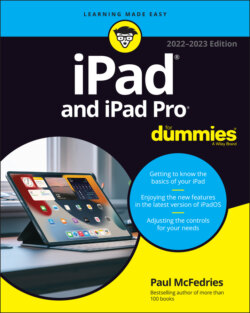Читать книгу iPad and iPad Pro For Dummies - Paul McFedries - Страница 26
Getting to know the dock
ОглавлениеAt the bottom of every iPad Home screen page, you see a special shelflike area called the dock. By default, the eight icons on the dock are as follows:
Messages: Exchange free, unlimited text or multimedia messages with any other device running iOS 5 or later or Mac OS X Mountain Lion or later. Find out more about Messages in Chapter 6.
Safari: Navigate sites and pages on the web. Chapter 4 shows you how to start using Safari on your iPad.
Music: Listen to music or podcasts. You discover how the Music app works in Chapter 7.
Mail: Send and receive email with most email systems. Chapter 5 helps you start emailing from your iPad everyone you know.
Calendar: Create and manage appointments. You learn more about Calendar in Chapter 11.
Photos: View, edit, and manage the photos in your iPad library. To get started, see Chapter 9.
Notes: Type short notes while you’re out and about. For help using Notes, flip to Chapter 11.
App Library: Get quick access to all your apps organized by category. I explain more in Chapter 10.
Feel free to add icons to or remove icons from the dock to suit the way your work or play. To add or remove dock icons, press and hold down on any icon and tap Edit Home Screen on the menu that appears. Your app icons will begin wiggling. Tap and drag a wiggling app icon to move it to or from the dock. Tap and drag an existing dock icon to change its position. When you’re satisfied, tap Done in the upper-right corner of the Home screen (or press the Home button, if your iPad has one) to exit wiggly mode and save your arrangement.
Depending on your iPad model, you have between 11 and 15 app icons on the dock. If you find you don't use App Library all that much, choose Settings ⇒ Home Screen & Dock and tap the Show App Library in Dock switch to off (that is, from a green background to a light gray background). You can now add an extra app icon to the dock.
Two last points:
Notifications are messages from iPadOS and your apps that tell you about recent activity on your tablet. I wanted to mention them even though they don’t have an icon of their own. You hear much more about notifications in Chapter 12. To see them now (I know you can’t wait), swipe from the top of your screen to the middle to make them appear. Then swipe from the bottom to put them away again. This gesture works anytime — even when your iPad is locked. If it’s locked, you’ll see your most recent notifications when you swipe down. Then swipe up to see older notifications.
I’d be remiss not to mention the useful Control Center, with controls for Wi-Fi, Bluetooth, audio playback, and much more, all available from any screen in any app. You discover much more about Control Center in Chapter 14, but if you can’t stand the suspense, put your finger in the top-right corner of your iPad screen and swipe down to open Control Center (and then tap some other part of the screen to put it away).
